
Darwinia, sometimes commonly known as mountain bells or simply bells, is a genus of about 70 species of evergreen shrubs in the family Myrtaceae, endemic to southeastern and southwestern Australia. The majority are native to southern Western Australia, but a few species occur in South Australia, New South Wales and Victoria. The genus was named in honour of Erasmus Darwin, grandfather of Charles Darwin by Edward Rudge in 1816. Most darwinias grow to a height of between 0.2 and 3 m, and many are prostrate shrubs. Most have small, simple leaves and the flowers are often grouped together, each flower with five red, white or greenish petals and ten stamens. In many species, the flowers are surrounded by large, colourful bracts, giving rise to their common names.

Darwinia citriodora, commonly known as lemon-scented darwinia or lemon scented myrtle, is a plant in the myrtle family Myrtaceae and is endemic to the south-west of Western Australia. It is a shrub with oblong to lance-shaped leaves and red, yellow and orange flowers over an extended period. It is a hardy plant in well-drained soil, is often cultivated and used as a rootstock for less hardy species.
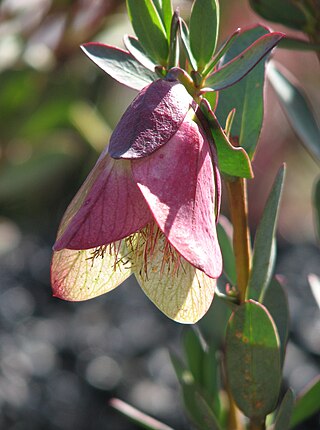
Pimelea physodes, commonly known as Qualup bell, is a species of shrub that is endemic to Western Australia. It has egg-shaped to narrow elliptical leaves and distinctive bell-like inflorescences with tiny greenish flowers surrounded by long elliptical bracts. The inflorescence resembles those of some of the only distantly-related darwinia "bells" and the bracts are a combination of red, purple, green and cream-coloured.

Darwinia collina, commonly known as the yellow mountain bell, is a plant in the myrtle family Myrtaceae. It grows as an erect shrub 0.3–1.2 metres (1–4 ft) high with crowded elliptical leaves and bright yellow flower-like inflorescences. It is endemic to a few small areas in the Stirling Range National Park, Western Australia and as a result is classified as an endangered species.

Darwinia apiculata, commonly known as the scarp darwinia, is a plant in the myrtle family Myrtaceae and is endemic to a small area in Western Australia. It is a rounded, densely branched, small shrub with thin red branches and scattered small leaves. The flowers are arranged in small groups on the ends of the branches, their most obvious feature being long, red, pointed bracts surrounding each flower and a longer red style with scattered hairs near its tip.

Darwinia biflora is a plant in the myrtle family Myrtaceae and is endemic to New South Wales. It is an erect, often straggly shrub with flattened, glabrous leaves, and flowers which are arranged in pairs. The flowers are greenish in colour but each is surrounded by two purple-red bracteoles and have a long yellow-green style projecting out of the flower tube. The species only occurs in the Sydney region in a few places where shale-capped ridges intergrade with Hawkesbury sandstone.
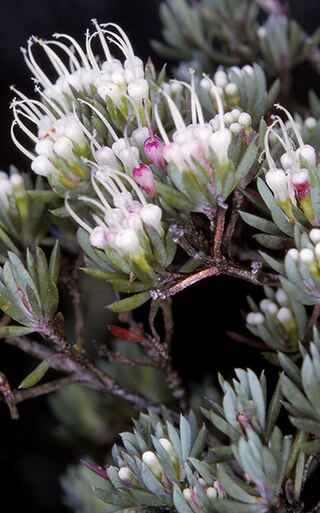
Darwinia camptostylis is a plant in the myrtle family Myrtaceae and is endemic to New South Wales and Victoria. It is small shrub with flattened, glabrous leaves and small clusters of green to yellow flowers. There are scattered populations in coastal areas where the plants grow in heath.
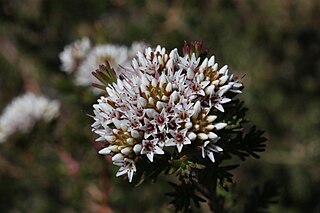
Darwinia capitellata is a plant in the myrtle family Myrtaceae and is endemic to the south-west of Western Australia. It is a bushy, many-branched shrub, very similar to Darwinia diosmoides but differs in the arrangement of its flowers, its more branched habit, prominent oil glands on the younger stems and its thinner, paper-like bracteoles. It was first discovered as a separate species when specimens of it were found to have a larger chromosome number than specimens of D. diosmoides.
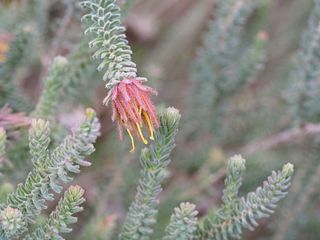
Darwinia chapmaniana, commonly known as Chapman's bell or Eganu bell, is a plant in the myrtle family Myrtaceae, and is endemic to the south-west of Western Australia. It is a low, rounded, spreading shrub with greyish, hairy leaves and flowers in heads of about 14 small, tubular flowers. The heads are surrounded by long, reddish-yellow, hairy bracts.

Darwinia wittwerorum, commonly known as Wittwer's mountain bell, is a plant in the myrtle family Myrtaceae and is endemic to a small area in Western Australia. An erect, spindly shrub with fine leaves and hanging groups of flowers surrounded by leaf-like bracts, it is one of the darwinias known as mountain bells.

Darwinia acerosa, commonly known as the fine-leaved darwinia, is a plant in the myrtle family Myrtaceae and is endemic to a small area in south-west of Western Australia. It is a densely branched, heath-like shrub with crowded, finely pointed leaves and drooping heads of forty to fifty yellowish-green flowers.

Darwinia ferricola, commonly known as the Scott River darwinia, is a plant in the myrtle family Myrtaceae and is endemic to a small area in Western Australia. It is a rounded, densely branched shrub with crowded, linear leaves mostly only on younger branches. The flowers are greenish-yellow and red, and arranged in groups on the ends of the branches, with a long white or reddish style protruding from the petal tube.

Darwinia hortiorum is a species of flowering plant in the myrtle family Myrtaceae and is endemic to Western Australia. It is a compact, densely branched shrub with small leaves and inflorescences composed of up to twenty flowers with glossy, pale yellow to reddish petals and fleshy dark green sepals surrounded by papery brown bracteoles.
Darwinia nubigena, commonly known as success bell or red mountain bell, is a species of flowering plant in the family Myrtaceae and is endemic to the south of Western Australia. It is an erect shrub with egg-shaped leaves arranged in opposite pairs, and groups of 4 or 5 pendent red flowers surrounded by larger green and red bracts.

Darwinia polychroma, commonly known as harlequin bell, is a species of flowering plant in the myrtle family Myrtaceae and is endemic to Western Australia. It has linear leaves and drooping flowers surrounded by yellowish green, green and red bracts.
Darwinia terricola, commonly known as the Blackwood bell, is a species of flowering plant in the myrtle family Myrtaceae and is endemic to a small area in the south-west of Western Australia. It is a small, low, sometimes prostrate shrub with small, linear leaves and small groups of flowers surrounded by reddish-green bracts and which usually lie on the ground.

Darwinia thymoides is a species of flowering plant in the myrtle family Myrtaceae and is endemic to the south-west of Western Australia. It is a low, spreading to prostrate shrub with linear to lance-shaped leaves and groups of 4 to 8 green, red or white flowers surrounded by leaf-like bracts.
Pultenaea pauciflora, commonly known as Narrogin pea, is a species of flowering plant in the family Fabaceae and is endemic to the south-west of Western Australia. It is a dense, erect, much-branched shrub with sickle-shaped leaves with a sharp point on the tip, and uniformly yellow flowers.
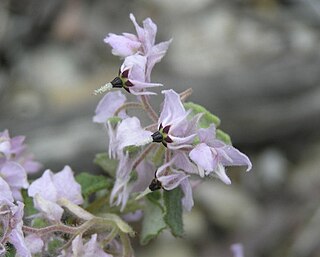
Lasiopetalum rotundifolium is a species of flowering plant in the family Malvaceae and is endemic to the south-west of Western Australia. It is an erect to spreading shrub with hairy young stems, round leaves with a heart-shaped base, and pink and dark red flowers.
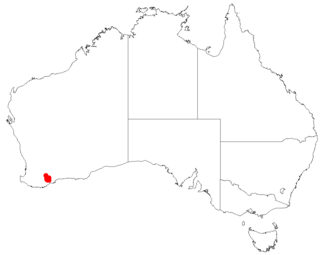
Leucopogon newbeyi is a species of flowering plant in the heath family Ericaceae and is endemic to a small area in the southwest of Western Australia. It is an erect shrub with densely hairy young branchlets, linear to narrowly elliptic or narrowly egg-shaped leaves and erect, compact clusters of 7 to 17 white, bell-shaped flowers mainly on the ends of branches.




















